1
![]()
Meet the Passengers: Problem Behaviors at Meetings and Their Effects
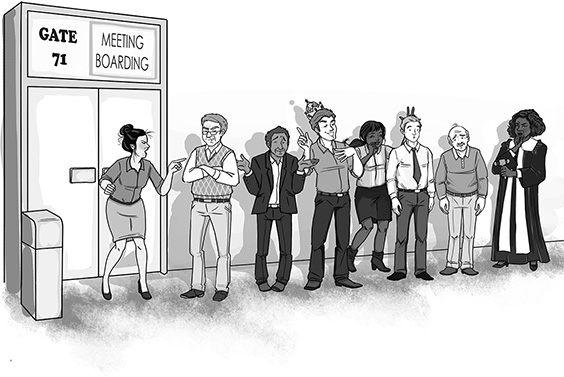
In the middle of every difficulty lies opportunity.
—ALBERT EINSTEIN
Let’s begin by looking at what we are up against with people. Given that most have too much to do and feel that half their time in meetings is a waste, they may already be in their stress response at a meeting. The problem behaviors people tend to exhibit when they are under stress are described in the book I cowrote with Dr. Rick Kirschner, Dealing with People You Can’t Stand: How to Bring Out the Best in People at Their Worst. In it, we emphasized that to be effective in bringing out the best in others, it is more functionally effective to think in terms of behavior rather than personality.
Personality is just a generalization we make based on the behaviors we observe in others. People’s behaviors change according to context (where they are and what is going on) and relationship (who they are with). You can know someone who seems to be a bully most of the time, but you may not realize what a wimp that person can be in a different context or a different relationship. My wife will tell you that she has to come to a seminar to hear me speak because in most social situations I’m pretty quiet.
Virtually all parents have experienced their child’s coming back from a play date and being surprised to hear the other parent say, “Oh, your child is so polite and helpful!” Different contexts, different behaviors; different relationships, different behaviors.
The reason this is critical to keep in mind is that we as human beings can pay attention to only seven, give or take two, things at any one time consciously. We have a part of our brainstem called the reticular activating system, or RAS for short. One of its many functions is radar. If you get married, you suddenly see everyone getting married. If you are having a baby, it looks like a baby boom. If you are interested in a certain car, you start seeing it everywhere. If you think somebody’s personality is negative, guess what you notice? You become consciously aware of all the times they’re negative and ignore any evidence when they’re not.
This is why it’s more effective to think in terms of behavior, because then you pay attention in the here and now to what’s going on in this context and relationship, and ultimately, you will be more effective. Think of it like clothing. Depending on where you’re going and the weather, you wear different outfits. A meeting is a specific context that seems to bring out the worst in people.
If meetings aren’t organized and are a waste of time, people are more likely to go into their stress behaviors. To make matters worse, one stress behavior usually triggers others. For example, if one person at a meeting is being controlling, then someone else who is also assertive might fight for control. As they vie for control, other participants might withdraw and stop contributing altogether or simply go along with whatever the most dominant person wants, never sharing what they really think until after the meeting.
In Dealing with People You Can’t Stand, we offered a way of organizing and understanding why people act the way they do. It is called the Lens of Understanding. The good news is that when you understand why people act the way they do at meetings, it’s the first step to understanding what to do about it. And the better news is that when you implement the process in this book—which I have tested and used for the last 20 years—you will prevent all these difficult behaviors from ever occurring. Really. I’m not kidding.
THE COOPERATION ZONE
Let’s take a look at the Lens of Understanding (Figure 1.1). Caution: this is not personality typing but behavior typing. All of us are capable of all these behaviors to varying degrees, depending on context and relationship. In this chapter, we are focused on behaviors created specifically in the meeting context.
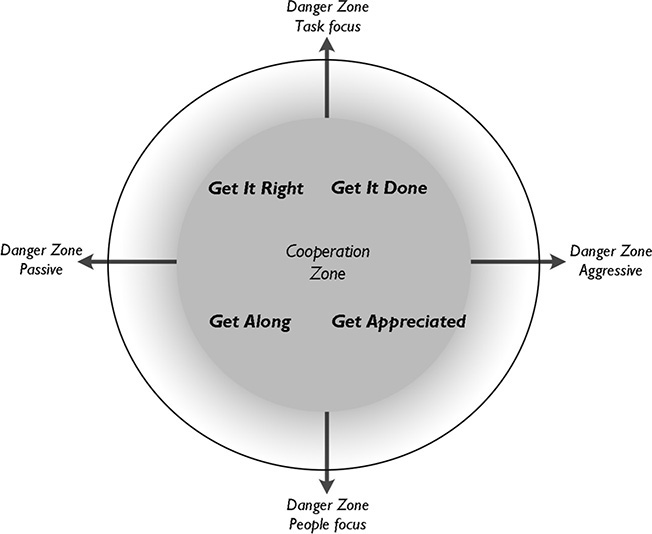
FIGURE 1.1 The Cooperation Zone
In the center we have a Cooperation Zone. When people are in that zone, there are no problems. And all people have within them four basic intents:
• Get it done
• Get it right
• Get along
• Get appreciated
Depending on context (where you are and what’s going on) and relationship (who you are with), one of these intents becomes primary, and behavior moves in that direction.
When people are in a Get it done mode, their behavior becomes focused on the task at hand and more assertive as they push forward to make it happen.
When people are in a Get it right mode, they remain focused on the task, but they tend to be less assertive as they slow things down to make sure it is done correctly.
When people are in a Get along mode, they are people focused and tend to be more passive, yielding to others and considering the needs of others above their own.
And when people are in a Get appreciated mode, they are people focused because that is where appreciation comes from. They become more assertive as they try to contribute to others to receive appreciation.
THE CAUTION ZONE
If people are not getting what they need in a particular situation, they enter the Caution Zone, where their behavior becomes a bit extreme (Figure 1.2). So if people are in a Get it done mode and they see things are not happening, they tend to get more Controlling. They take over in an effort to Get it done.
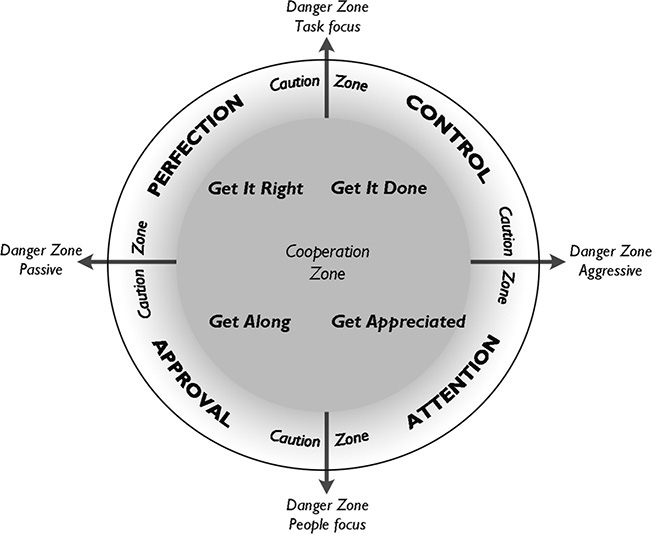
FIGURE 1.2 The Caution Zone
When people are in a Get it right mode and they perceive others are not paying enough attention to the details, they compensate by becoming more Perfectionist.
If people are in a Get along mode but they are worried about potential conflict or the disapproval of others, their behavior becomes more Approval seeking.
And if people are in a Get appreciated mode and they feel others aren’t paying attention to them, their behavior becomes more Attention seeking.
As you begin to pay closer attention to people’s behaviors at meetings, you will notice how they communicate and act out of these intents and behaviors:
Get it done and Controlling
Get it right and Perfectionist
Get along and Approval seeking
Get appreciated and Attention seeking
The Caution Zone is not necessarily a problem. In fact, sometimes it’s a solution. Somebody takes control and moves things forward, or someone makes sure all the details are covered.
THE DANGER ZONE
If people really get stressed out, they can enter the Danger Zone (Figure 1.3). Let’s examine what the behaviors are, where they originate, why they’re detrimental to a meeting, and how they affect others.
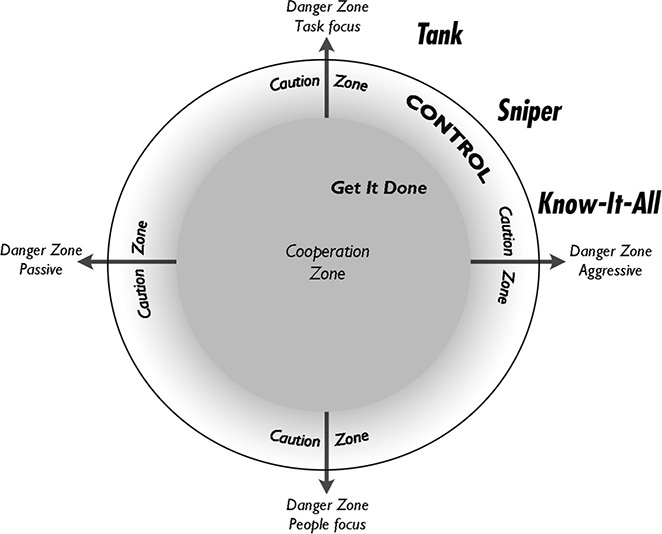
FIGURE 1.3 The Danger Zone: Tanks, Snipers, and Know-It-Alls
Originating out of a desire to Get it done and Control, we find the behaviors of Tank, Sniper, and Know-it-all.
Tanks
When people become Tanks, they will interrupt, dominate, and roll over others with their point of view. They may even make a direct attack. Tank behavior originates from a desire to Get it done and keep things under Control. People become Tanks when they perceive that a situation is out of control and/or things are not getting done. They are in such an extreme Get it done and Control mode that people’s feelings are secondary to moving forward, which is why they can be so ruthless. They may attack others personally; ironically, it’s nothing personal. They perceive that people stand in the way of a result or are taking too long, so they simply eliminate them.
A Tank’s effect at meetings varies according to where others are in the Lens of Understanding, as well as their position in the organization in relation to the Tank. Most, especially subordinates, will simply withdraw and acquiesce to the Tank’s point of view, becoming Yes and Nothing People. In the long term they will stop verbally participating at meetings for fear of a Tank attack.
When people suppress anger or resentment, they can easily become Snipers or saboteurs, as we will see. Those subordinates who may harbor resentment about the Tank’s behavior are more likely to snipe or perform acts of sabotage behind the Tank’s back, while those at the same level as the Tank may make sniping (sarcastic) comments directly at the Tank during the meeting. This of course creates further disruptions. In contrast, a peer who is equally Get it done and Controlling may opt for an all-out Tank-to-Tank battle in the middle of the meeting.
Snipers
Sniping can take many forms, both verbal and nonverbal, and have different intents, malicious and friendly. Verbal sniping is the sarcastic comment, the sarcastic tone, or the barbed jab disguised as a joke. It can also take the form of questions or comments aimed to sabotage a presentation, or it can be a side conversation at the meeting. Nonverbal sniping takes the form of facial expressions such as the eye roll or smirk.
Malicious sniping originates from a Get it done and Control mode. The Sniper has some partially suppressed resentment or anger and can control a meeting by having others live in fear of being shot. Friendly sniping originates from a Get appreciated and Attention-seeking mode. These Snipers may actually like the person at whom they are sniping. Whatever the form, sniping still distracts from the purpose of the meeting by causing a lack of focus. It is also likely that others at the meeting might join in the sniping either by sniping at the snipee (in jest or maliciously) or sniping at the Sniper because they resent the distraction. A Sniper at a meeting can invite a Tank attack because the Get it done Tank will be furious at the Sniper for being distracting. Some may simply withdraw and become Nothing People, and others may respond with whining or negativity, if not at the meeting, certainly afterward.
Even if the snipee isn’t cut down by the Sniper and is wearing a bulletproof vest in terms of his or her self-esteem, the Sniper’s effect on the meeting can be devastating. After a Sniper comment, the others in the room will be focused on the snipee (thinking, “What will she do next?”), the sniper (“What will he do next?”), and themselves (“What would I do in that situation?”). Basically, everyone’s attention is somewhere else. Once sniping starts, focus at the meeting is over.
Know-It-Alls
Know-it-all behavior originates from a Get it done and Control mode. Know-it-alls are very knowledgeable and use their knowledge to control things at a meeting. Although task focused, they are not as task focused as Tanks. When you combine knowledge with a big ego, you get a Know-it-all who will go on and on, dominating the meeting. Maybe they do know 95 percent of a particular subject, but if we remove only 5 percent of the parts of an airplane, are you ready to go for a flight? Of course not! Even if others at a meeting have only 5 percent to contribute, that 5 percent is important. But because Know-it-alls can be intimidating and condescending with their knowledge, most people at a meeting will give up trying to express themselves and simply turn into Nothing People. Know-it-all behavior is detrimental to meetings in two ways: they waste time with their pontificating, and they shut others down.
Let’s move to another area of the Lens of Understanding in which people want to Get appreciated and they develop a need for attention (Figure 1.4). This produces the behaviors of Think-they-know-it-alls, Grenades, and Friendly Snipers.
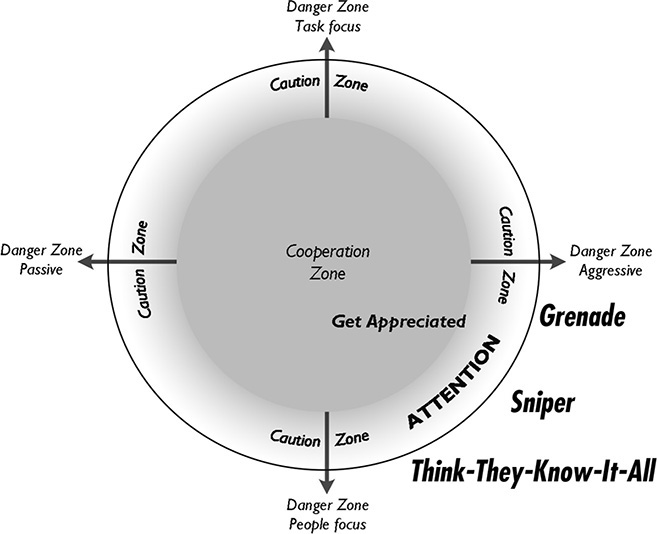
FIGURE 1.4 The Danger Zone: Grenades, Think-They-Know-It-Alls, and Friendly Snipers
Think-They-Know-It-Alls
This behavior can be even more frustrating because they act like Know-it-alls, but they really don’t know what they are talking about. It originates from a Get appreciated and Attention-seeking mode. They have an even greater ego need to be the center of attention than Know-it-alls have.
They are detrimental to meetings in two ways. First, they waste time going on and on to hear themselves talk. Second, they can mislead a group with bad ideas. If others don’t know the subject that Think-they-know-it-alls are talking about, it’s easy to follow them off a cliff and into the sea. They can easily trigger a Tank attack or cause in others the sudden need to check their e-mail on their phones for something to do.
Grenades
This behavior is the classic tantrum. It originates from a Get Appreciated and Attention-seeking mode. They have bottled up a lot of stress, and then their pin is pulled. Often it is because they feel they are not being listened to or their contribution is not being appreciated. Once the tantrum starts, everything else stops. The meeting has really ended. The disruption of the Grenade would infuriate anyone who wants to get things done, so this easily turns other people into Tanks.
When a Tank attacks a Grenade, it is like pouring gasoline on a fire. In the face of a Grenade tantrum, most run for cover by withdrawing and becoming Nothing People. A long-term effect of having Grenades at meetings is that people walk on eggshells around them and are a little more withdrawn. But this can make it more likely for a Grenade to blow up again because when people are withdrawn, they don’t give the Grenade the level of attention the Grenade seeks.
Friendly Snipers
Friendly sniping at its nicest can be lighthearted teasing or put-down humor. It’s not really meant to hurt anyone, and Friendly Snipers truly are just kidding. It originates from a Get appreciated and Attention-seeking mode. The teasing is a way of making a connection. However, in the context of a meeting, it is still a distraction. And yes, a joke can lighten up a meeting, but when it’s at the expense of another person or happens frequently, it is a distraction. It can easily push Get it done people to become Tanks because all sniping is a distraction. Worse, it can be contagious, with others becoming Friendly Snipers too. It may be good for a few laughs, but the focus at the meeting is fractured.
Let’s examine another area of the Lens of Understanding in which people want to Get it right and develop a need for perfection (Figure 1.5). This produces the behaviors of Whiners, No People, Judges, and Nothing People.

FIGURE 1.5 The Danger Zone: Whiners, No People, Judges, and Nothing People
Whiners
Whining begins in the Get it right and Perfection mode. They see what could be, compare it with what is, and then feel helpless to do anything about it. At its root, whining comes from feelings of helplessness and disempowerment. Whiners feel they are the victims of other people and circumstances. Then two things happen. Whiners look only at what is wrong with ideas and dismiss them with generalizations such as “Nothing is right,” “Everything is wrong,” and “It is always that way.” Since looking at the specifics of problems is the first step to problem solving, they offer nothing of constructive value.
The Whiner’s complaining eventually deflates everyone else at the meeting, robbing them of their energy and creativity. Unfortunately, whining is contagious. It can spread like the flu through a team, and before you know it, everyone at the meeting is doing it.
No People
This is negativity at its worst. It also originates from the Get it right and Perfection mode. No People are first cousins to Whiners. Whereas Whiners are helpless, No People are hopeless. They are very sure of their negative opinions and, therefore, are more aggressive about spreading the doom and gloom.
No People shoot down ideas before they have a chance to take flight. Like Whiners, they tend to speak in broad generalizations about everything being wrong, but with even more confidence and conviction. They have the arrogance of a Know-it-all seduced by the dark side of the force. Negativity is also a virulent behavior. It will sap the creativity and energy of everyone at the meeting. Of course, No People won’t think they did anything wrong. Their motto is, “I’m not being negative. I’m being realistic!”
Judges
While Whiners and No People speak in generalizations, Judges focus on what’s wrong by nitpicking the details. They too originate from the Get it right and Perfection mode. At a meeting, Judges will be overly focused on details that may not be significant or even meaningful to the discussion. Their net result at a meeting is to waste time and take the group down unnecessary tangents. This can easily trigger anyone in the Get it done mode while compelling others to withdraw in quiet misery.
Nothing People
These are the people who simply say nothing. Their behavior originates from Get it right and Perfectionist frustration. They give up and say, “Fine, do it your way, but don’t come crying to me when it doesn’t work out.”
However, there is a type of Nothing People that originates from the Get Along and Approval-seeking area of the Lens of Understanding (Figure 1.6) who believe that if you don’t have something nice to say, don’t say it at all. In this area you also get Yes People who are agreeable but you don’t know where they stand and Maybe People who can’t make a decision.

FIGURE 1.6 The Danger Zone: Nothing People, Yes People, and Maybe People
No matter what the motivation for Nothing behavior, Get it right and Perfectionist or Get along and Approval seeking, you never hear from them at meetings. They do not participate, and you don’t know where they stand. One detriment to the meeting is that their valuable contributions are lost. Another is that they can become passive-aggressive and later engage in sabotage because they didn’t agree with the decisions made. After the meeting, they can also easily become Whiners or No People because they feel like victims of decisions that they had a chance to affect but did not.
Therefore, their detriment to the meeting is threefold. One, they simply don’t contribute; two, they can become passive-aggressive; and three, they create a wide open space where some of the more assertive behaviors of Tanks, Snipers, and Know-it-alls can dominate.
Yes People
Yes behavior originates from a Get along and Approval-seeking mode. The last thing they want is to make waves. They will avoid conflict at all costs by suppressing their true feelings and just going along with everyone else. This creates two detriments at a meeting. One is the loss of their valuable contribution or perspective. The other is that when they disagree with decisions made at the meeting, they don’t give voice to it. This can lead to passive-aggressive behavior as they engage in subtle acts of sabotage or sniping afterward because of their resentment.
Yes People may also feel like victims, which can turn them into Whiners or No People. Feeling helpless is the root of whining, whereas feeling hopeless is the root of negativity. At the meeting, they are happy to yield the floor to the more assertive behaviors, allowing those people and their opinions to dominate.
Maybe People
Maybe behavior also originates from a Get along and Approval-seeking mode. This is essentially a Yes Person faced with making a decision that could hurt someone’s feelings. Since Maybe People don’t want to do that, they will stall and put the decision off until it is too late. Then the decision is made by default and they are not to blame. At meetings, if a boss who is the final decision-maker or too many participants become Maybe People, it will lead to multiple meetings on the same topic as the group recycles discussions and information that it should have acted on long ago.
Every one of these Danger Zone behaviors will quickly destroy a meeting (Figure 1.7). To make matters worse, each Danger Zone behavior tends to trigger Danger Zone behaviors in others.

FIGURE 1.7 The Danger Zone Composite
After the meeting, it will only get worse because if people feel that their time was wasted, they will go into some other stress behavior. They might switch into Get it done mode and exhibit Tank behavior. Or if they react by feeling helpless or hopeless, they might turn into Whiners and No People who spread their misery to others who weren’t even at the meeting.
Here’s the good news: with the Meeting Jet process, I’ll show you how you can prevent all of these behaviors from occurring in the context of a meeting. If you need surefire strategies to pull people out of these difficult behaviors and prevent them in the first place in other contexts and relationships, please read Dealing with People You Can’t Stand.
GREAT MOMENTS IN MEETINGS
The Old Have-to-Pee Trick
Back in the 1990s I worked for a well-known telecom R&D lab that had purchased your Difficult People videos. At the time, I worked with a Grenade. This particular engineer would explode at any time for seemingly any reason. During one particular design meeting, he was doing his usual ranting and raving. I really needed to use the restroom, so I just got up and left the meeting without explanation.
When I returned, another engineer pulled me aside and told me that my approach was masterful. What approach? The Grenade assumed that I had walked out in silent protest of his behavior. He instantly reformed and became useful. My implied rebuke apparently sobered him, much to my amazement.
—Engineer, Telecom R&D lab
SUMMARY
1. People’s behaviors change according to context and relationship.
• Context = where they are and what is going on
• Relationship = who they are with
2. The Cooperation Zone: Everyone has four basic intents, and whichever is foremost at the time affects their behavior.
• Get it done = task focus and assertive
• Get it right = task focus and passive
• Get along = people focus and passive
• Get appreciated = people focus and assertive
3. The Caution Zone: If people are not getting what they need, they go into the Caution Zone, which is not always a problem and is sometimes a solution.
• Get it done = task focus and assertive become Controlling
• Get it right = task focus and passive become Perfectionist
• Get along = people focus and passive become Approval seeking
• Get appreciated = people focus and assertive become Attention seeking
4. The Danger Zone: If people get really stressed out, they go into the Danger Zone.
• Get it done = task focus and assertive become Controlling
![]() Tanks
Tanks
![]() Snipers
Snipers
![]() Know-it-alls
Know-it-alls
• Get appreciated = people focus and assertive become Attention-seeking
![]() Think-they-know-it-alls
Think-they-know-it-alls
![]() Friendly Snipers
Friendly Snipers
![]() Grenades
Grenades
• Get it right = task focus and passive become Perfectionist
![]() Whiners
Whiners
![]() No People
No People
![]() Judges
Judges
![]() Nothing People
Nothing People
• Get along = people focus and passive become Approval-seeking
![]() Nothing People
Nothing People
![]() Yes People
Yes People
![]() Maybe People
Maybe People
